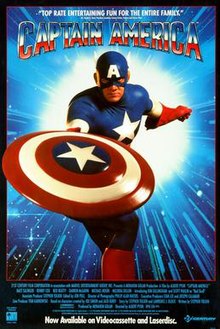
Captain America is a superhero created by Joe Simon and Jack Kirby who appears in American comic books published by Marvel Comics. The character first appeared in Captain America Comics #1, published on December 20, 1940, by Timely Comics, a corporate predecessor to Marvel. Captain America's civilian identity is Steve Rogers, a frail man enhanced to the peak of human physical perfection by an experimental "super-soldier serum" after joining the United States Army to aid the country's efforts in World War II. Equipped with an American flag-inspired costume and a virtually indestructible shield, Captain America and his sidekick Bucky Barnes clashed frequently with the villainous Red Skull and other members of the Axis powers. In the final days of the war, an accident left Captain America frozen in a state of suspended animation until he was revived in modern times. He resumes his exploits as a costumed hero and becomes leader of the superhero team the Avengers, but frequently struggles as a "man out of time" to adjust to the new era.

The Red Skull is a supervillain appearing in American comic books published by Marvel Comics and its predecessor Timely Comics. In Captain America Comics #1, the Red Skull's secret identity was revealed to be George Maxon; It would be retroactively established that he was merely a decoy who was working for the real Red Skull. Albert Malik would later adopt the Red Skull mantle, only to be killed in a plot orchestrated by the original.

Hulk is a 2003 American superhero film based on the Marvel Comics character of the same name, created by Stan Lee and Jack Kirby. Produced by Universal Pictures in association with Marvel Enterprises, Valhalla Motion Pictures, and Good Machine, and distributed by Universal, it was directed by Ang Lee and written by James Schamus, Michael France, and John Turman, from a story conceived by Schamus. The film stars Eric Bana as Bruce Banner and Hulk, alongside Jennifer Connelly, Sam Elliott, Josh Lucas, and Nick Nolte. The film explores Bruce Banner's origins. After a lab accident involving gamma radiation, he transforms into a giant green-skinned humanoid with superhuman strength known as the Hulk whenever stressed or emotionally provoked. The United States military pursues him, and he clashes with his biological father, who has dark plans for his son.

The Falcon is a superhero appearing in American comic books published by Marvel Comics. The character was introduced by writer-editor Stan Lee and artist Gene Colan in Captain America #117, and was the first Black American superhero in mainstream comic books.

Sharon Carter is a character appearing in American comic books published by Marvel Comics. Created by Stan Lee, Jack Kirby, and Dick Ayers, the character first appeared in Tales of Suspense #75. Sharon Carter is a secret agent and an ex-field agent of S.H.I.E.L.D. under Nick Fury. She is also a love interest of the superhero Captain America / Steve Rogers. Sharon Carter was originally the younger sister of Peggy Carter. She was later retconned as Peggy's grand-niece because of the unaging nature of comic book characters.

Sin is a supervillain appearing in American comic books published by Marvel Comics. The character is the daughter of the Red Skull and an enemy of Captain America.
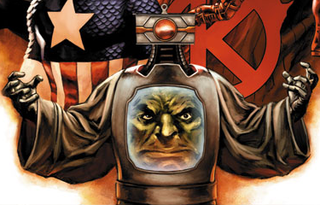
Arnim Zola is a supervillain appearing in American comic books by Marvel Comics. He is a master of biochemistry and a recurring enemy of Captain America and the Avengers. The character first appeared in Captain America and the Falcon #208, and was created by writer/artist Jack Kirby. When he was first introduced, Zola was a Nazi scientist experimenting with genetic engineering during World War II. His skills as a geneticist drew the attention of the Red Skull, who recruited him into Hydra to aid their efforts to create super soldiers. One of his experiments led to the brain of Adolf Hitler being copied into a being later known as Hate-Monger. Later in life, Zola transferred his own mind into a sophisticated robot body which protected it by storing it in its chest and displaying a digital image of Zola's face on its chest plate. This robot body allowed Zola to survive until modern times, as whenever it is destroyed, Zola could simply upload his consciousness into a new body.
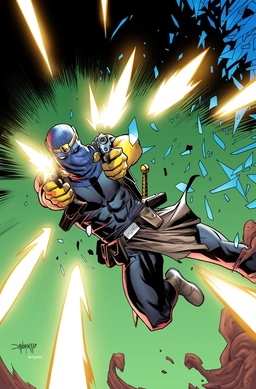
Helmut Zemo is a character appearing in American comic books published by Marvel Comics. Created by Roy Thomas, Tony Isabella and Sal Buscema, the character first appeared in Captain America #168. Helmut Zemo is the son of Baron Heinrich Zemo and the thirteenth Baron Zemo in his family lineage. He is a recurring adversary of the Avengers, especially the superhero Steve Rogers / Captain America. The character has also been known as Citizen V at various points in his history.
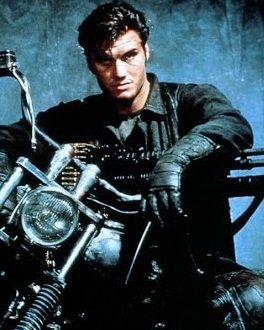
The fictional character Frank Castle / Punisher, a comic book vigilante antihero created by Gerry Conway, John Romita Sr. and Ross Andru and featured in Marvel Comics publications, has appeared as a main character in multiple theatrical, several animated straight-to-video films, and three fan films. Most notably, he has appeared in two self-titled films, the first in 1989 with Dolph Lundgren in the title role and the second in 2004 with Thomas Jane in the title role, as well as Punisher: War Zone, starring Ray Stevenson.

"The Death of Captain America", also known as "The Death of the Dream", is an eighteen-issue Captain America story arc written by Ed Brubaker with art by Steve Epting and published by Marvel Comics. The arc first appears in Captain America #25–30. The first issue of the story arc, Captain America #25, was the highest selling comic for the month of its release. The story arc had wide-sweeping effects throughout the Marvel Universe and was accompanied by the miniseries Fallen Son: The Death of Captain America.

Captain America: Reborn is a six-issue monthly comic book limited series published by Marvel Comics between July 2009 and January 2010. The series was written by Ed Brubaker, illustrated by Bryan Hitch, and inked by Butch Guice. The series reveals the truth regarding the death of the original Captain America, Steve Rogers and revives him in the contemporary Marvel Universe.

Margaret Elizabeth "Peggy" Carter is a fictional character appearing in American comic books published by Marvel Comics. She is usually depicted as a supporting character in books featuring Captain America. Created by writer Stan Lee and artist Jack Kirby, she debuted, unnamed, in Tales of Suspense #75 as a World War II love interest of Steve Rogers in flashback sequences. She would later be better known as a relative of Sharon Carter.
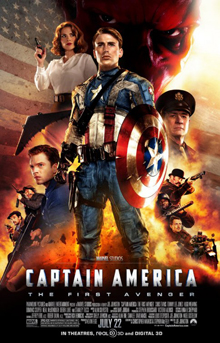
Captain America: The First Avenger is a 2011 American superhero film based on the Marvel Comics character Captain America. Produced by Marvel Studios and distributed by Paramount Pictures, it is the fifth film in the Marvel Cinematic Universe (MCU). The film was directed by Joe Johnston, written by Christopher Markus and Stephen McFeely, and stars Chris Evans as Steve Rogers / Captain America alongside Tommy Lee Jones, Hugo Weaving, Hayley Atwell, Sebastian Stan, Dominic Cooper, Toby Jones, Neal McDonough, Derek Luke, and Stanley Tucci. During World War II, Steve Rogers, a frail man, is transformed into the super-soldier Captain America and must stop the Red Skull (Weaving) from using the Tesseract as an energy source for world domination.

Marvel Animated Features (MAF) is a series of eight direct-to-video animated superhero films made by MLG Productions, a joint venture between Marvel Studios and Lions Gate Entertainment.
Heroes United is a series of direct-to-video animated superhero films from Marvel Animation. They are the first full-length direct-to-video CG animated features created by the animation studio. Both films are available to stream on Disney+.
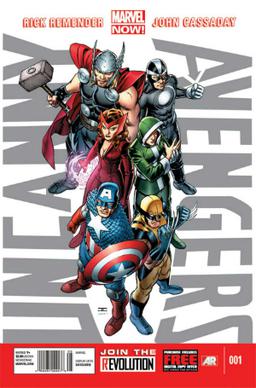
Uncanny Avengers is a comic book series first appearing in the October 2012 debut of Marvel NOW!, published by Marvel Comics. The series follows an interconnected fictional superhero team, featuring members from the Marvel Universe. The team is united by Captain America upon the conclusion of Avengers vs. X-Men. Uncanny Avengers is also known as Avengers Unity Squad.

Captain America, a superhero created by Joe Simon and Jack Kirby who appears in comic books produced by Marvel Comics, has appeared in multiple films since the character's inception in 1940. Republic Pictures released a fifteen-part Captain America serial film in 1944 that was the first film to feature a Marvel Comics character, though it deviated significantly from the comic book source material. Two made-for-TV films, Captain America and Captain America II: Death Too Soon, aired on the American broadcast television station CBS in 1979. A feature-length film directed by Albert Pyun was originally planned for a wide theatrical release in 1990, but received only a brief theatrical release in the United Kingdom before being released in the United States as a direct-to-video film.

James Buchanan "Bucky" Barnes is a character appearing in American comic books published by Marvel Comics. Originally introduced as a sidekick to Captain America, the character was created by Joe Simon and Jack Kirby and first appeared in Captain America Comics #1. Barnes' original costume and the Bucky nickname has been used by other heroes in the Marvel Universe over the years.
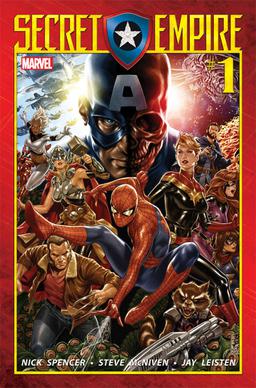
"Secret Empire" is a 2017 Marvel Comics crossover storyline published by Marvel Comics, consisting of a 10-issue, eponymous miniseries written by Nick Spencer and illustrated by Rod Reis, Daniel Acuña, Steve McNiven, and Andrea Sorrentino, and numerous tie-in books. The storyline addresses the aftermath of the storyline "Avengers: Standoff!" and the ongoing series Captain America: Steve Rogers, in which Captain America has been revealed to be acting as a sleeper agent and covertly setting the stage to establish the terrorist organization Hydra as the main world power. The entire crossover received mixed reviews.

Captain America: White is a six-issue Marvel Comics limited series written by Jeph Loeb and illustrated by Tim Sale. An homage to Captain America comics from the Golden Age of Comic Books, the series focuses on the relationship between Steve Rogers / Captain America and his sidekick Bucky. It is the fourth and final comic in Loeb's and Sale's "Color" series, following Daredevil: Yellow, Spider-Man: Blue, and Hulk: Gray. The series is noted for its extensive production delays, with seven years elapsing between the release of the first and second issues.
